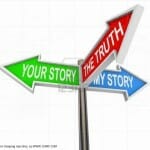 Last Sunday, Seth Godin posted his daily blog. It was titled, “A True Story.”
Last Sunday, Seth Godin posted his daily blog. It was titled, “A True Story.”
In his pithy comment Godin stated, “There’s no such thing as a true story. As soon as you start telling a story, making it relevant and interesting to me, hooking it into my worldviews and generating emotions and memories, it ceases to be true, at least if we define true as the whole truth, every possible fact, non-localized and regardless of culture.”
As I stopped to ponder this brief passage, I couldn’t help but think about my memoir and memoirs in general. Many have questioned the truthfulness of all memoirs. Exaggerations of verifiable facts and blatant lies are now commonplace in this genre as prepublication fact checking becomes passé. Are memoirists intentionally moving farther away from the truth in order to capture their readers’ attention or is it merely their interpretation of distant events and conversations? Each author will have to answer that question independently.
In light of this criticism, I had internal pressure to stay within the boundaries of truth. Obviously, my perception of facts may or may not be the same as someone else’s recollection. It was as if I was a small child who meticulously attempted to remain within the dark outlined areas in a coloring book. I selected an assortment of contrasting colors in varying degrees of intensity in order to create my unique masterpiece while others may have completed the picture differently.
As I wrote, I staunchly adhered to my recollections even though I was advised that I had some leeway in my presentation. Despite this flexibility, I never purposely chose to make a broad sweep of my hand that would have left any color outside the prescribed area. As my story unfolded and I began to weave the events together, I was also reminded that I had to maintain a certain pace and level of interest so that I would not lose my audience. I soon realized that it was impossible to include every fact.
Was the truth altered? No. Kernels of truth were always prominent. My completed memoir, much like a page in one of my childhood coloring books, adhered to my intended goals. (read a sample excerpt) My soon to be published memoir is engaging while still conforming to the truth.
Sandra Bornstein is the author of MAY THIS BE THE BEST YEAR OF YOUR LIFE. It is available on Amazon.
If you enjoyed reading my memoir, consider posting a review on Amazon, Goodreads, LibraryThing and/or AskDavid.com.
My memoir covers a time period of many years ago.Where my memory fails, I tend to use some material that may or may not have been true. It is impossible not to color some of the facts to make them more interesting to a reader. Is this being dishonest?
Marjorie,
You raise a great question that more memoir writers should ask themselves. If you cannot remember parts of your story, should you take the liberty to create an engaging story that is a figment of your imagination? If you’re labeling your story as a memoir, your content should be based on true events. If it is not based on actual happenings, I would not categorize the work as a memoir. Perhaps, a work of fiction would be a better option. Many memoir writers choose to embellish a select group of facts. When that happens, the line between being honest and dishonest can become blurred if the author’s intentions are misleading.